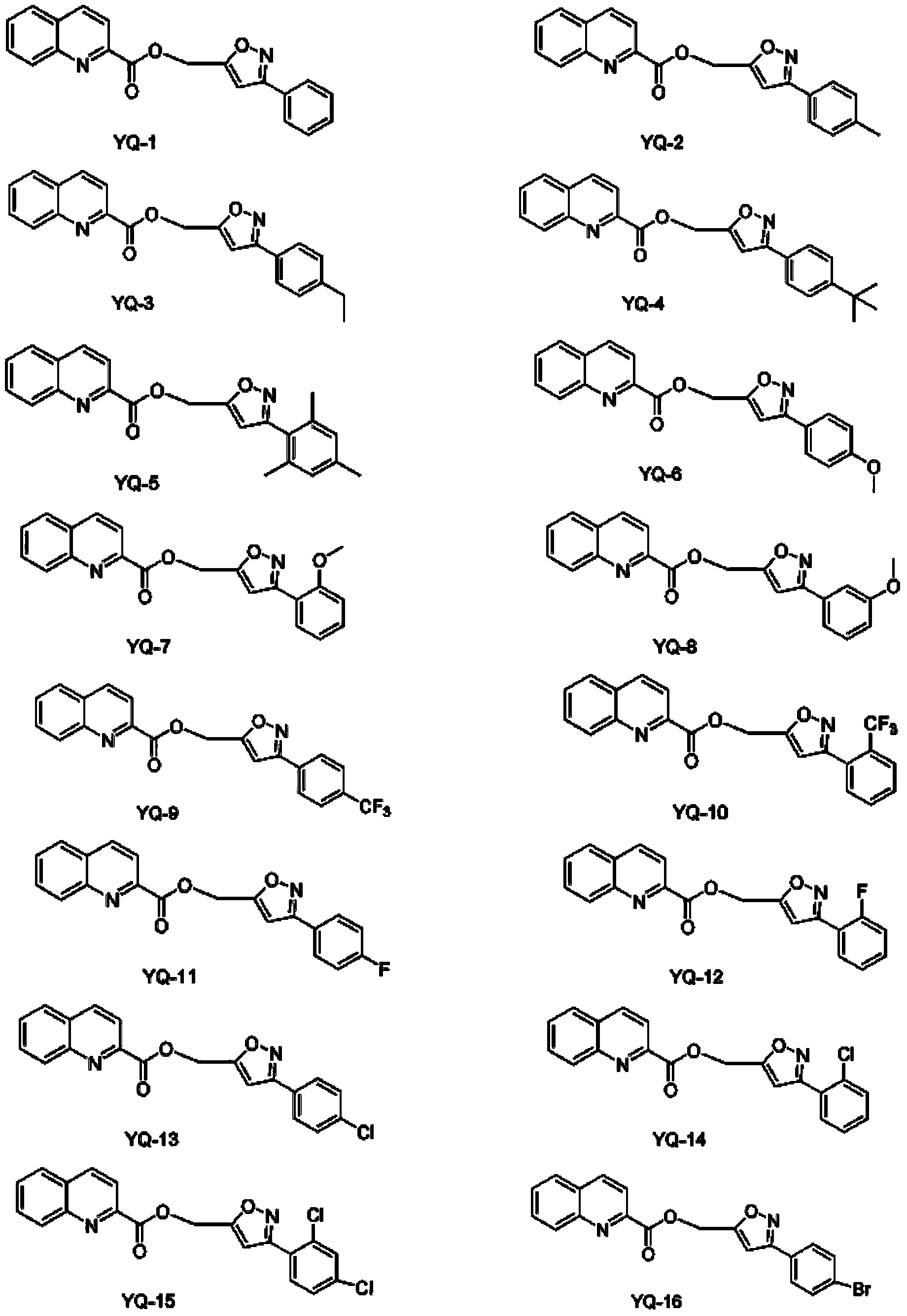Quinoline derivative as well as preparation method and application thereof
A kind of derivative, the technology of quinoline, applied in the preparation and the pharmaceutical composition containing such derivative, the field of quinoline-2-carboxylate derivatives, can solve the problem of affecting physiological function, injuring normal cells, normal cytotoxicity kill, etc.
- Summary
- Abstract
- Description
- Claims
- Application Information
AI Technical Summary
Problems solved by technology
Method used
Image
Examples
Embodiment 1
[0060] Example 1 Synthesis of intermediate 3-substituted phenyl-5-hydroxymethyl-isoxazole (II) or intermediate 3-substituted phenyl-5-aminomethyl-isoxazole (III):
[0061] Using substituted benzaldehyde as raw material, it is prepared by synthesis of oxime, 1,3-dipolar cycloaddition reaction, methylsulfonyl esterification reaction, azidation, and reduction reaction (R and n are as above), see the following process for details :
[0062]
[0063] For the specific synthesis process of intermediate 3-substituted phenyl-5-hydroxymethyl-isoxazole (II) or intermediate 3-substituted phenyl-5-aminomethyl-isoxazole (III), please refer to the applicant The publication numbers of the previous applications are three applications of CN103360382A, CN103664991A and CN103601762A, the full text of which is incorporated herein by reference.
Embodiment 2
[0064] Synthesis of quinoline derivatives (I-1) shown in embodiment 2 formula (I):
[0065] Where R is H as an example to illustrate:
[0066] Synthesis of [(3-phenyl-isoxazol-5-yl)-methyl]-quinoline-2-carboxylate (YQ-1)
[0067]
[0068] Add 0.167g (1mmol) of quinoline-2-carboxylic acid and 0.206g (1mmol) of DCC into a 50mL round bottom flask, add 10mL of dry THF, and stir in an ice bath for 30min to dissolve 0.175g (1mmol) of 5-hydroxymethyl A 10 mL THF solution of 1-3-phenyl-isoxazole and 0.122 g (1 mmol) DMAP was slowly added dropwise to the reaction system, stirred in an ice bath for 30 min, and then naturally rose to room temperature for reaction. After the completion of the TLC detection reaction, the reaction solution was concentrated in vacuo, and the residue was directly column separated [V (petroleum ether): V (ethyl acetate) = 5:1~2:1] to obtain the target compound [(3-phenyl-isoxan (Azol-5-yl)-methyl]-quinoline-2-carboxylate (YQ-1). The rest of the compounds...
Embodiment 3
[0069] Synthesis of quinoline derivatives (I-2) shown in embodiment 3 formula (I):
[0070] where R is H as an example to illustrate
[0071] Synthesis of N[(3-phenyl-isoxazol-5-yl)-methyl]-quinoline-2-carboxamide (YQ-20)
[0072]
[0073] Add 0.167g (1mmol) of quinoline-2-carboxylic acid, 0.206g (1mmol) of DCC and 0.135g (1mmol) of HOBT into a 50mL round bottom flask, add 10mL of dry THF, stir and react in an ice bath for 30min, and dissolve 0.174g (1mmol) 5-aminomethyl-3-phenyl-isoxazole and 0.122g (1mmol) DMAP in 10mL THF solution were slowly added dropwise to the reaction system, stirred in an ice bath for 30min, and then naturally rose to room temperature for reaction. After the reaction was detected by TLC, the reaction solution was concentrated in vacuo, and the residue was directly separated by column [V (petroleum ether): V (ethyl acetate) = 5:1~2:1] to obtain the target compound N[(3-phenyl-iso Oxazol-5-yl)-methyl]-quinoline-2-carboxamide (YQ-20). The remaining...
PUM
 Login to View More
Login to View More Abstract
Description
Claims
Application Information
 Login to View More
Login to View More - R&D
- Intellectual Property
- Life Sciences
- Materials
- Tech Scout
- Unparalleled Data Quality
- Higher Quality Content
- 60% Fewer Hallucinations
Browse by: Latest US Patents, China's latest patents, Technical Efficacy Thesaurus, Application Domain, Technology Topic, Popular Technical Reports.
© 2025 PatSnap. All rights reserved.Legal|Privacy policy|Modern Slavery Act Transparency Statement|Sitemap|About US| Contact US: help@patsnap.com



